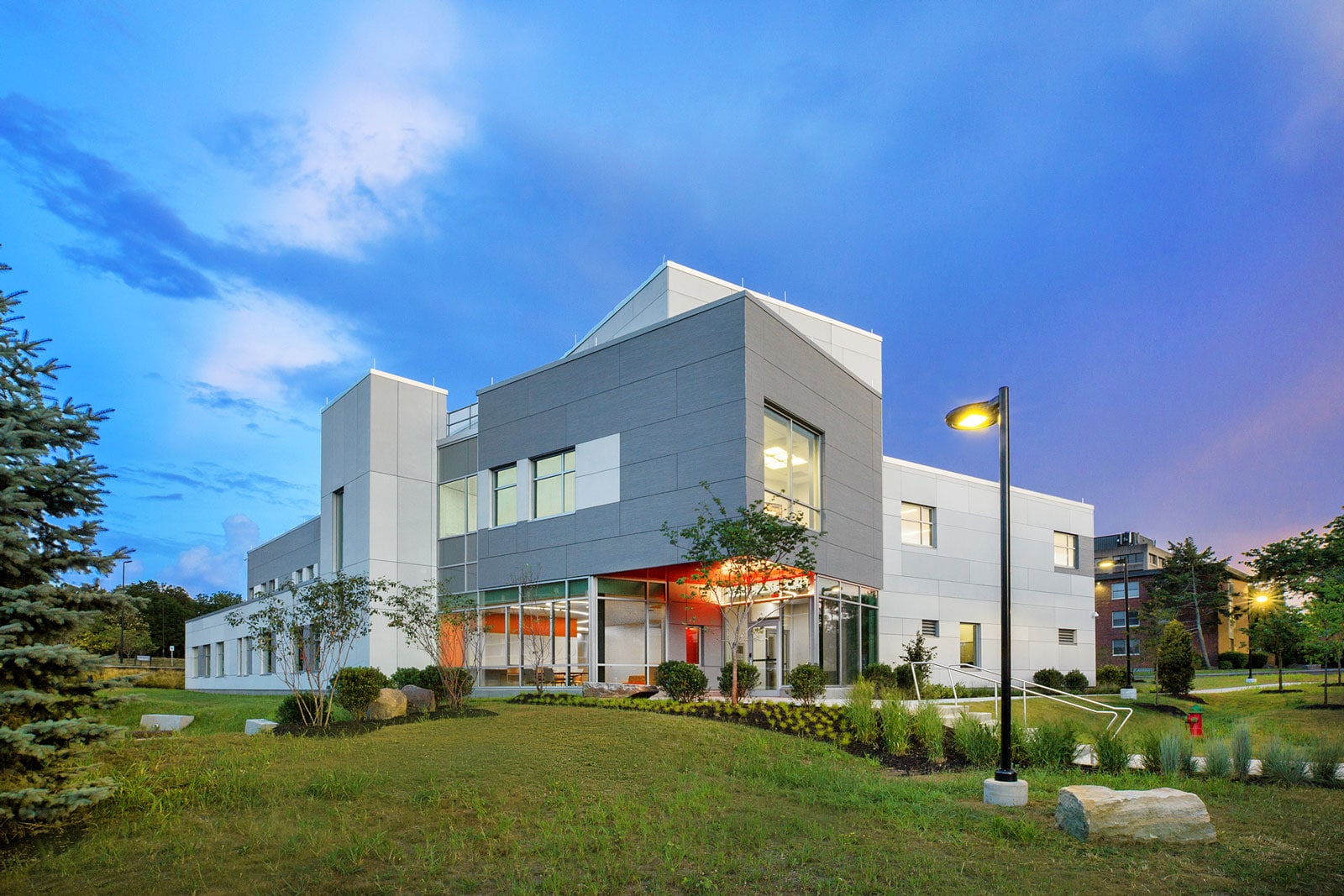Story at a glance:
- Green building rating systems help to incentivize sustainable building principles.
- LEED and BREEAM are two of the most popular green building rating systems in the world.
- Programs like the Living Building Challenge take a holistic approach to designing green buildings.
Studies have shown that the built environment is responsible for 40% of the world’s total carbon emissions, while the construction and demolition industry as a whole generates approximately 30% of the globe’s waste and accounts for over one-third of global resource extraction.
The only way to reduce these figures is by radically rethinking the way in which we plan, design, build, and use the built environment—and green building rating systems can help provide a guiding framework to do just that.
In this article we explore 12 of the most popular green building rating systems from around the world.
What is a Green Building Rating System?

Designed by JLG Architects, Gorecki Alumni Center at the University of North Dakota is the first LEED Platinum project in North Dakota. SketchUp and Sefaira were used to model and analyze building performance from the start of the project. JLG was able to reduce the client’s cost by approximately $1M, reduce energy use by 53%, achieve zero fossil fuel use for heating and cooling and garner 97% user satisfaction. Photo courtesy of JLG Architects
Green building rating systems are well-established programs and tools used to assess architectural development projects that have taken steps to improve their operational performance from an environmental perspective. Buildings that have been assessed and recognized as meeting predetermined performance or quality guidelines may receive various certifications.
Green Building Rating Systems
The number of green building rating systems has increased dramatically over the last two decades, with more than 100 systems currently in operation around the globe. Here are 12 of the most popular, in no particular order.
LEED
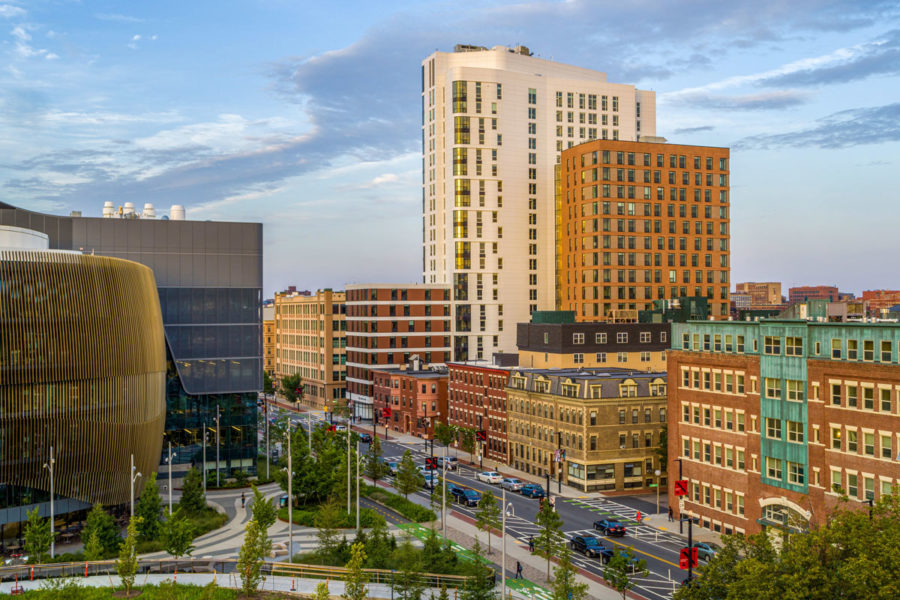
Architectural firm CUBE 3 collaborated with American Campus Communities to design the 20-story, LEED-certified student housing community. Photo copyright of Flaunt Boston & CUBE 3
Created in 1994 by the newly founded USGBC, the Leadership in Energy and Environmental Design (LEED) rating system is the foremost green building certification program in North America and was devised to both encourage and honor the adoption of sustainable development practices in the built environment.
There are currently 21 LEED frameworks tailored to various types of building projects, of which are inclusive of both new construction as well as existing buildings. Projects receive LEED certification by first meeting the program’s mandated prerequisites and then gaining credit points. There are currently 110 optional credits to choose from, although the pending release of LEED v5 in early 2025 is slated to introduce new credits.
There are four levels of LEED certification—Certified, Silver, Gold, and Platinum—determined by the amount of credit points earned. LEED v5 is set to introduce new requirements for Platinum certification, ultimately making the distinction harder to achieve, but also making it that much more meaningful.
- Certified (40 – 49 points)
- Silver (50 – 59 points)
- Gold (60 – 79 points)
- Platinum (80+ points)
As of 2025 there are over 195,000 LEED-certified buildings around the world.
DGNB
In 2009 the Deutsche Gesellschaft für nachhaltiges Bauen (DGNB)—or German Sustainable Building Council—introduced a green building rating system of the same name, of which was created in partnership with the German Federal Ministry of Traffic, Construction, and Urban Development.
DGNB is based on the life cycle assessment, holistic sustainability, and use of performance-based approaches. Rather than assess individual measures the DGNB considers the overall performance of a project, with different certifications and pre-certifications existing for various stages of a building’s lifespan. In total the DGNB System encompasses new construction and renovation, district development, buildings in use, interior fittings, deconstruction of building stock, and construction sites.
Any project pursuing DGNB-certification must be assessed on the basis of various categories, all of which have their own specific weightages. Depending on the type of project the structure of the certification system and the number/type of criteria considered can vary widely. An in-use building, for example, would be subject to the following assessments, criteria, and weightages:
- Ecological quality (33.3%). Assesses climate action and energy, water, as well as materials and recycling.
- Economical quality (33.3%). Assesses operating costs, risk management and long-term asset value, as well as procurement and operations.
- Sociocultural and functional quality (33.3%). Assesses indoor comfort, user satisfaction, and mobility.
DGNB projects will require an auditor to conduct the necessary assessments, of whom is appointed by the project contractor. If a project qualifies for certification, it may receive one of four ratings based on its percentage score:
- Bronze (30% and higher)
- Silver (50% and higher)
- Gold (65% and higher)
- Platinum (80% and higher)
As of February 2025 over 10,000 buildings have received DGNB certification, the majority of which are located in European countries.
BREEAM
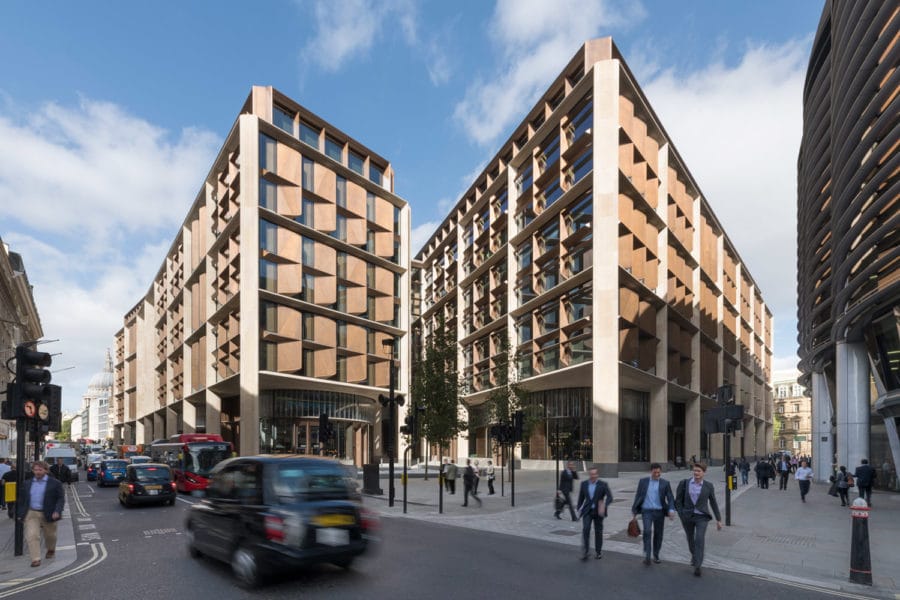
Designed by Foster + Partners, the Bloomberg European Headquarters office building in London possesses one of the highest BREEAM ratings in the world. Photo by Nigel Young
BREEAM—or the Building Research Establishment Environmental Assessment Method—was developed in 1990 by the Building Research Establishment and is said to be the world’s longest established method for assessing, rating, and certifying the sustainability of buildings.
There are different BREEAM schemes designed for various types of projects, including new construction, in-use buildings, and refurbished or renovated buildings. BREEAM assesses projects based on the following categories: management, water, energy, transport, health and well-being, resources, resilience, land use and ecology, pollution, materials, waste, and innovation.
Depending on how well they implement strategies within these categories, buildings seeking BREEAM certification are rated on a scale of Pass, Good, Very Good, Excellent, and Outstanding:
- Pass (≥30)
- Good (≥45)
- Very good (≥55)
- Excellent (≥70)
- Outstanding (≥85)
One of the world’s highest-scoring BREEAM-certified buildings is the Bloomberg European Headquarters office in London, which received an impressive 98.5% rating.
And while BREEAM primarily certifies buildings in Europe, it does rate projects elsewhere and has certified buildings in over 100 countries. Current estimates suggest there are over one million BREEAM-certified buildings—and more than double that number registered for certification—around the globe.
EDGE
Excellence in Design for Greater Efficiencies (EDGE) was created in 2014 by the International Finance Corporation (IFC) and places a high focus on achieving energy, water, and resource efficiency. The EDGE App allows developers and builders to identify the most cost-effective strategies for reducing energy use, water consumption, and embodied carbon
There are three levels of EDGE certification:
- EDGE Certified. Requires a reduction of 20% or more in energy, water, and the embodied energy in materials.
- EDGE Advanced. Requires a project be EDGE certified and demonstrate a 40% reduction in on-site energy use.
- EDGE Zero Carbon. Requires a project be EDGE Advanced certified and that 100% of all energy is produced by on- or off-site renewables or that all energy is offset by purchased carbon credits (all carbon, including from diesel and LPG, must be accounted for).
Buildings can receive preliminary certification at the end of the design phase following a design audit and a final certificate at the end of the post-construction phase following a site audit.
Projects that achieve EDGE or EDGE Advanced certification do not need to be recertified, but any building that is awarded EDGE Zero Carbon certification must be recertified every two years if achieved through offsets or every four years if achieved through renewables.
Living Building Challenge
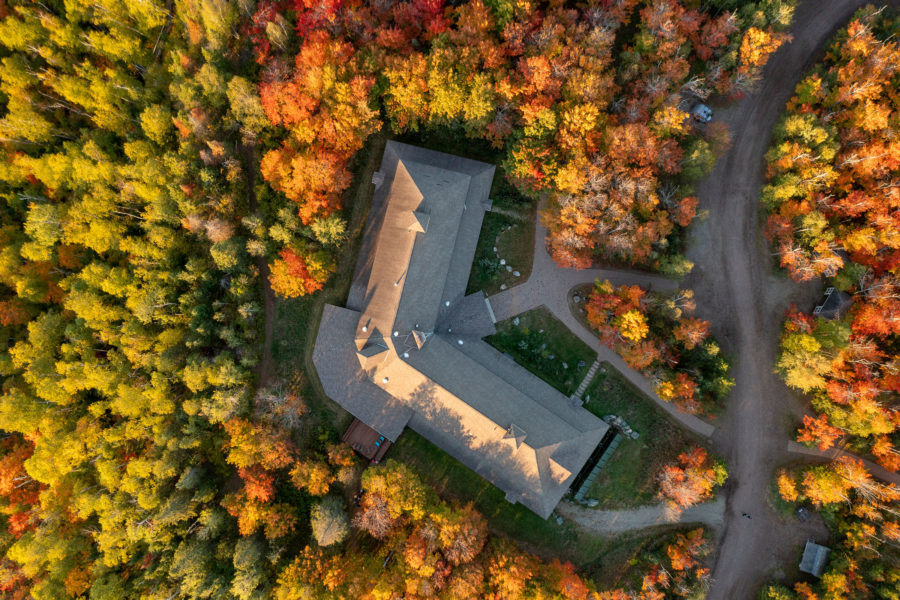
MAC Lodge at the Wolf Ridge Environmental Learning Center in Minnesota was the first renovation project to ever complete the Living Building Challenge. Photo by Chad Holder
Developed by architect Jason McLennan in collaboration with the Cascadia Green Building Council and run by the International Living Future Institute (ILFI), the Living Building Challenge (LBC) is an extremely rigorous green building rating system that encourages the design and construction of regenerative buildings, or buildings that ultimately have a positive impact on the environment.
There are four core typologies or project categories supported by the LBC: new buildings, building renovations, interior renovations, and landscape or infrastructure. Each typology uses the same basic flower-inspired framework encompassing seven distinct petals representing seven key performance areas: place, water, energy, health and happiness, materials, equity, and beauty.
- Place. Necessitates the careful consideration of site and context before the design process even begins in order to better understand local factors and the impact construction will have on both the environment and community during its construction and operation.
- Water. Requires that buildings be designed to only use the amount of water that can be collected on-site and purified without the aid of chemicals; often manifests in the form of integrated rainwater harvesting systems, greywater recycling, compostable toilets, et cetera.
- Energy. Aims to reduce fossil fuel dependency and energy consumption by requiring that projects produce 105% of the energy they need year-round via renewable sources.
- Health and happiness. Places a high importance on remedying the source of health problems by improving indoor air quality, visual comfort, acoustic comfort, and thermal comfort, as well as fostering a stronger connection to the natural world (i.e. biophilic design).
- Materials. Focuses primarily on eliminating the use of building materials that are known to have a negative impact on human, environmental, and public health; requires all materials be free of Red List compounds and necessitates careful documentation of all materials/products used.
- Equity. Requires that a project does not disturb others’ access to clean water, sunlight, or fresh air and that it is accessible to all peoples, especially those belonging to vulnerable populations.
- Beauty. While not subjectively defined, this petal encourages architects to put genuine effort into designing beautiful buildings that inspire and elevate lives of not just the building’s occupants but also visitors, neighbors, and the community at large.
Each petal is then subdivided into imperatives, of which there are a total of 20 spread throughout the seven petals—10 of those imperatives are required while the remainder are considered supplementary. Different levels of LBC certification require compliance with varying numbers of imperatives.
- Core certification. Projects pursuing Core certification only need to achieve the 10 core LBC imperatives.
- Petal certification. Designed for projects that want to focus primarily on one performance area; requires that all core imperatives be met as well as all imperatives within the Water, Energy, or Materials petals.
- Living certification. Geared towards projects aiming to achieve the highest level of sustainability, health, equity, and regenerative design; requires that all imperatives assigned to a project’s typology are met (only projects in the “New Building” typology are required to meet all 20 imperatives).
All LBC imperatives can be applied to almost any project, in just about any location—but the ILFI also recognizes that regional variables like climate heavily impact the way in which certain imperatives are addressed. And because the Living Building Challenge is based on actual, rather than modeled, performance, projects must demonstrate compliance with all necessary imperatives over the course of 12 consecutive months to be eligible for certification.
As of February 2025 over 250 projects have achieved some level of LBC certification, while over 500 projects are currently in the process of pursuing certification.
NGBS
Created in 2008 by the International Code Council, National Association of Home Builders, and ASHRAE, the National Green Building Standard (NGBS) is the only American National Standards Institute (ANSI) approved green building rating system designed specifically for residential projects. NGBS-eligible buildings include single-family homes, affordable housing, low- and high-rise multifamily housing, residential portions of mixed-use buildings, and renovations of existing homes.
Any project that aims to become NGBS-certified must include a NGBS Green Verifier on their project team. Verifiers are independent, in-field accredited representatives of NGBS who perform the two mandatory third-party verification inspections that all NGBS projects are subject to. During these inspections the Verifier takes note of the green building practice used throughout the building, each of which counts towards points that then inform the final rating.
The NGBS separates green building practices into six general categories:
- Lot development. Takes into account walkability, effective on-site stormwater management strategies, low-maintenance landscaping, and the preservation of existing trees.
- Resource efficiency. Emphasizes the use of advanced framing techniques to conserve natural resources, reduce construction waste and cost, and optimize the home’s overall structural performance; also prioritizes the use of roof overhangs, drip edges, and ice dams to help prevent moisture intrusion and protect insulation.
- Energy efficiency. Includes strategies like proper insulation, air sealing, use of energy-efficient lighting and appliances, tight air ducts, and more to help reduce a building’s overall energy consumption.
- Water efficiency. Prioritizes the use of low-flow plumbing fixtures and appliances that conserve water to reduce a project’s overall water requirements.
- Indoor environmental quality. Emphasizes the use of non-toxic, low-VOC materials and proper ventilation.
- Operation and maintenance. NGBS provides each certified building with an owner’s manual to help residents protect, operate, and maintain their properties in ways that have a minimal environmental impact and which extend the service life of their equipment.
Once the points from these green building practices are tallied up, a final rating is given. There are four potential certification levels awarded by the NGBS: bronze, silver, gold, and emerald.
- Bronze (231 points)
- Silver (334 points)
- Gold (489 points)
- Emerald (611 points)
As of February 2025 over 520,360 green housing units have been rated and certified by the NGBS in the United States.
Passive House
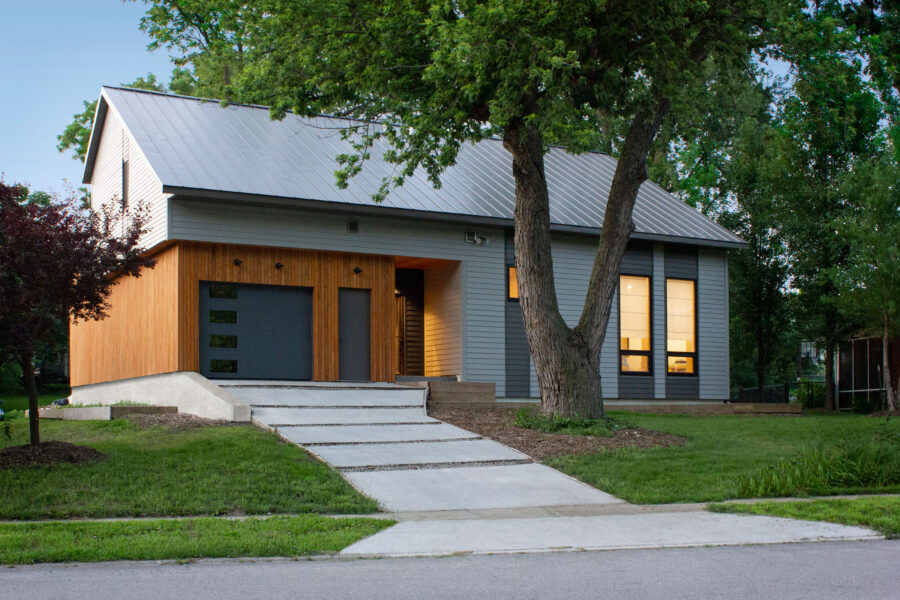
The Iowa City Nest residence is an all-electric, low-carbon Phius Certified project. Photo by Carl Sterner
There are two major green building rating systems that deal with the “passive house” concept: the Passivhaus Institut (PHI) and the Passive House Institute U.S. (PHIUS).
PHI & iPHA
Founded in 1996, the PHI is an independent research institute that has played a crucial role in developing and standardizing the passive house concept, a tried-and-true construction method that combines careful planning and technology to drastically reduce a building’s energy consumption.
For a building to be considered a passive house by PHI standards, it must meet the following criteria:
- The building’s space heating energy demand cannot exceed 15 kWh per square meter of net living space per year or 10 W per square meter during peak demand (the criteria for space cooling demand is very similar but has an additional, climate-dependent allowance for dehumidification).
- The primary energy demand may not exceed 120 kWh annually for all domestic applications (heating, cooling, hot water, and electricity) per square meter of usable living space.
- With regard to airtightness, a building cannot exceed 0.6 ACH at 1 pound per square foot of pressure (ACH@50 Pa), as verified by on-site pressure tests.
- The thermal comfort of all living areas must be met during winter and summer, with no more than 10% of the hours in a given year exceeding 25℃ (77℉).
All of these requirements may be achieved through the implementation of five core passive design principles:
- Thermal insulation
- Energy-efficient windows
- Ventilation heat recovery
- Superior airtightness
- Elimination of thermal bridges
Buildings designed to the Passive House Standard may be certified as such by a Passivhaus Institut-accredited Building Certifier once they have meticulously inspected the building’s systems and components.
The Passivhaus Institut has also taken steps to bring the Passive House Standard to the global stage through its creation of the International Passive House Association (iPHA), a worldwide network of Passive House scientists, developers, architects, planners, manufacturers, suppliers, and contractors. It’s estimated that there are now more than 47,400 projects built to PHI standards across the globe, with more being constructed every year.
PHIUS
Originally created as an offshoot of PHI, PHIUS has since become a separate entity with a different set of certification criteria tailored to the climatic conditions found throughout North America. In general, however, PHIUS prioritizes the same passive design principles that form the foundation of the PHI certification program.
There are two categories of PHIUS certification—Phius CORE and Phius ZERO—of which projects may pursue. Phius CORE is available for all new construction projects and offers a holistic approach to energy conservation. The basic criteria for achieving Phius CORE includes:
- Implementation of passive building principles
- Superior airtightness
- Active conservation of energy
- Integration of renewable energy
- Use of appropriate moisture design
- Window comfort
- Electric vehicle charging infrastructure
- Combustion and fireplace safety
- Electrification readiness for combustion equipment
- Third-party on-site inspection
Phius ZERO is built off of the same basic concepts as Phius CORE but takes things a step further by limiting a project’s net source energy target to zero, forbidding the use of on-site fossil-fuel combustion, and requiring on- and off-site renewable energy production.
Since its inception in 2015 PHIUS has certified over 3,300 projects in the United States.
GSAS
Created by the Gulf Organization for Research and Development (GORD), the Global Sustainability Assessment System (GSAS) is the first integrated, performance-based system for assessing and rating buildings in the Middle East and North Africa (MENA) region.
There are three types of GSAS certifications, each tailored to a different component or phase of a project’s life cycle: GSAS Design & Build (for new buildings), GSAS Construction Management (for ongoing building and infrastructure projects), and GSAS Operations (for existing buildings).
The GSAS framework is split into eight key categories—Urban Connectivity, Site, Energy, Water, Materials, Indoor Environment, Cultural & Economic Values, and Management & Operations—each of which encompasses a range of criteria. The weight of each category is determined by the aggregation of individual criteria weights belonging to that category. Using these weightages a project can score anywhere from a 0 to a 3.
A building’s rating depends on the category of project being certified. GSAS Design & Build, for example, has six ratings ranging from 1 to 6 stars:
- 1 star (0.00 ≤ X ≤ 0.50)
- 2 stars (0.50 < X ≤ 1.00)
- 3 stars (1.00 < X ≤ 1.50)
- 4 stars (1.50 < X ≤ 2.00)
- 5 stars (2.00 < X ≤ 2.50)
- 6 stars (2.50 < X ≤ 3.00)
GSAS Construction Management, on the other hand, only has five possible ratings ranging from ‘Class D’ to ‘Class A*’:
- Class D (0.5 ≤ X < 1.0)
- Class C (1.0 ≤ X < 1.5)
- Class B (1.5 ≤ X < 2.0)
- Class A (2.0 ≤ X < 2.5)
- Class A* (X ≥ 2.5)
Finally, GSAS Operations also has five potential ratings ranging between ‘Bronze’ and ‘Diamond’:
- Bronze (0.5 ≤ X < 1.0)
- Silver (1.0 ≤ X < 1.5)
- Gold (1.5 ≤ X < 2.0)
- Platinum (2.0 ≤ X < 2.5)
- Diamond (X ≥ 2.5)
Qatar currently has the highest number of GSAS buildings in the MENA region, boasting over 2,400 registered projects.
WELL Building Standard

Perkins Eastman’s Chicago studio is the first project in Illinois to receive WELL Platinum certification under the WELL v2 pilot. Photo courtesy of Perkins Eastman
Developed by Delos Living LLC and administered by the International WELL Building Institute (IWBI), the WELL Building Standard is a performance-based standard and certification program designed to evaluate how buildings impact the health and wellbeing of their occupants.
Like many green building rating systems, WELL is constantly evolving and has gone through several iterations since its launch in 2014—the most recent version, WELL v2, is built on ten key concepts: air, water, nourishment, light, fitness, comfort, and mind.
- Air. Implementation of strategies to remove airborne contaminants, prevent indoor air pollution, and purify incoming or recirculated air to optimize indoor air quality.
- Water. Optimize the quality of water through extensive filtration and treatment while promoting accessibility through strategic placement of fixtures.
- Nourishment. Encourage the adoption of healthy eating habits by providing occupants with nutritional food choices, healthy behavioral cues, and knowledge about nutrient quality.
- Light. Promote exposure to natural light and create lighting environments that are beneficial to occupants’ visual, mental, and biological health.
- Movement. Use of design elements, policy, and programs that encourage physical activity in everyday life.
- Thermal Comfort. Ensure thermal comfort and productivity through the use of improved HVAC system design and control.
- Sound. Bolster occupant health, productivity, and wellbeing by designing acoustically-comfortable spaces that limit or mitigate noise pollution.
- Materials. Reduce human exposure to hazardous building material ingredients by restricting or altogether eliminating compounds, chemicals, and products known to be toxic.
- Mind. Use of strategic design elements, state-of-the-art technology, and relaxation spaces to support occupants’ mental health and emotional wellbeing.
- Community. Aims to support equal access to essential healthcare, workplace promotion, accommodations for new parents, and the development of integrated communities through accessible design, civic engagement, and social equity.
These concepts are addressed through the application of WELL Features, of which there are over 100 of across all ten categories. Features are categorized as either preconditions—that is, they are required for baseline certification—optimizations, with the latter providing points that determine a project’s eventual rating.
Projects aiming for WELL certification must include all preconditions, submit project documentation, and undergo an on-site audit, after which they may receive either a Bronze, Silver, Gold, or Platinum rating based on the number of points earned.
- Bronze (40+)
- Silver (50+)
- Gold (60+)
- Platinum (80+)
Current reports suggest that the WELL Building Standard is being used across over 5 billion square feet of space in 130 countries.
BOMA 360 Performance Program
The Building Owners and Managers Association’s (BOMA) 360 Performance Program is an international green building rating system that has set the standard for holistic operational best practices with regard to the commercial real estate sector.
Buildings eligible for BOMA 360 Performance Program designation include commercial office buildings—a designation that includes multi-tenant, single-tenant, corporate facilities, government buildings, medical office buildings, suburban office parks, and mixed-use structures—and industrial buildings that are at least 50% occupied or leased at the time of application.
The BOMA 360 Performance Program focuses on six main areas:
- Building operations and management (15+ points)
- Life safety/security/risk management (8+ points)
- Training and education (10+ points)
- Energy (10+ points)
- Environmental sustainability (5+ points)
- Tenant relations and community involvement (7+ points)
Buildings that receive BOMA 360 designation must renew their designation every three years. Over 13,000 buildings have been awarded BOMA 360 Performance Program designation since it launched in 2009.
Fitwel
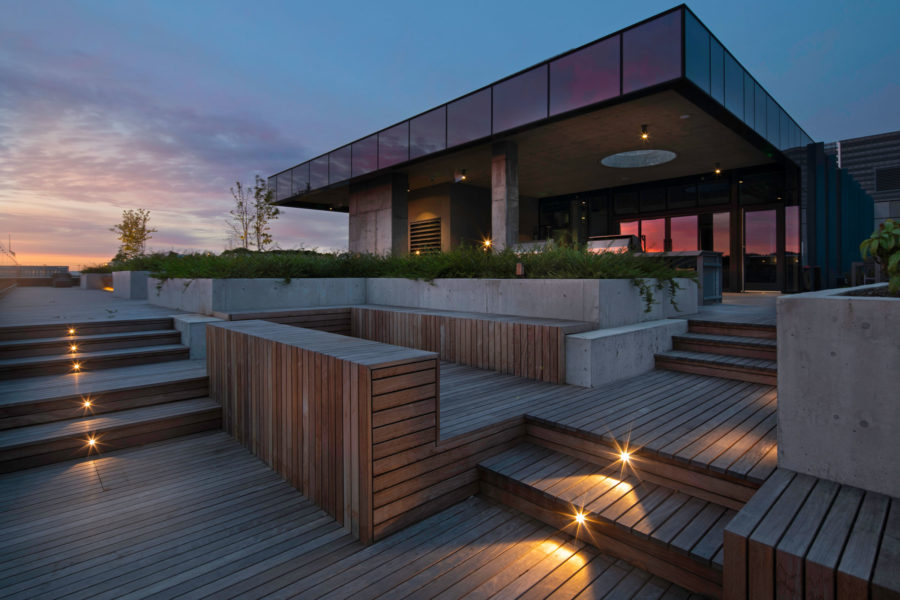
The 5 MLK Boulevard project has been certified for LEED Gold, Salmon Safe, and is the first mixed-use building in the US with a Fitwel certification, according to GREC Architects. Photo by Quanta Collectiv
Similar to WELL, Fitwel is another green building rating system that looks at how a building affects the health and wellbeing of its occupants. Originally developed in 2016 by the CDC in partnership with the General Services Administration, Fitwel is currently administered by the Center for Active Design, an organization that promotes architectural and urban planning solutions that better the health and engagement of our nation’s communities.
Building’s aiming for Fitwel certification are assessed on how well they integrate strategies across seven key health impact categories:
- Impacts surrounding community health. Encompasses those strategies that go beyond improving the health of a building’s occupants and instead impact the health of the community at large.
- Reduces morbidity and absenteeism. Includes strategies that help to reduce morbidity and employee absenteeism by improving occupant mental health, lessening the spread of infectious diseases, and decreasing the development of chronic illnesses.
- Supports social equity for vulnerable populations. Refers to those strategies that support vulnerable populations (e.g. the elderly, disabled, children, and low-income persons) by increasing access to health-promoting opportunities.
- Instills feelings of well-being. Includes strategies that promote feelings of relaxation, inclusion, and perceptions of safety through the provisioning of biophilic experiences, clean spaces, and ample opportunities for equitable social engagement.
- Enhances access to healthy foods. Refers to those strategies that promote healthier eating choices, reduce the cost of healthier food options, and diversifying the outlets and sources of nutritional food options.
- Promotes occupant safety. Encompasses strategies that protect occupants by increasing staircase safety, reduce the risk of crime and injury, and shield pedestrians and cyclists from vehicular traffic.
- Increases physical activity. Includes strategies that encourage active transportation (e.g. walking, cycling, et cetera), promoting stair use (but not at the expense of accessibility), and expanding access to both indoor and outdoor fitness areas and/or equipment.
When assessing a property Fitwel representatives use a scorecard that includes over 55 evidence-based design and operational strategies known to improve buildings by addressing various health behaviors and risks. Each strategy has its own unique point allocation based on how it impacts occupant health. Depending on the amount of points earned, a project may be awarded one of three levels of Fitwel certification:
- 1 star (90 – 104 points)
- 2 stars (105 – 124 points)
- 3 stars (125 – 144 points)
Once earned, Fitwel certification is valid for three years, after which point projects must submit for recertification.
CASBEE
Japan’s Comprehensive Assessment System for Built Environmental Efficiency (CASBEE) is one of the first green building rating systems to be implemented in Southeast Asia. Launched by the Japan Sustainable Building Consortium (JSBC) in 2001, the CASBEE family of tools was designed to accommodate a range of building types throughout various stages of construction, of which are divided into four core categories: CASBEE for Pre-Design, CASBEE for New Construction, CASBEE for Existing Building, and CASBEE for Renovation.
In terms of framework, CASBEE uses Built Environmental Efficiency (BEE) as its assessment factor, which is further divided into two factors: quality (Q) and load (L).
- Quality. Evaluates the improvement in living amenity for the building’s users within the enclosed space and assesses the indoor environment, quality of service, and outdoor environment.
- Load. Evaluates the negative aspects of the building’s environmental impact which go beyond the enclosed space and assesses energy, resources and materials, and the off-site environment.
A building’s BEE figure is calculated by dividing the Q numerator by the L denominator. Once that figure is calculated, CASBEE will assign the project a performance assessment rating ranging from C through B, B+, A, and S:
- C (Poor—1 star)
- B (Fairly poor—2 stars)
- B+ (Good—3 stars)
- A (Very good—4 stars)
- S (Excellent—5 stars)
And because the Japanese government has made a commitment to reaching carbon neutrality by 2050, the CASBEE family of assessment tools all require that a life-cycle assessment of the carbon dioxide (LCCO2) emitted during a building’s construction, operation, and eventual demolition be conducted. These results are then compared to the LCCO2 of a suitable reference building that satisfies the Energy Conservation Law standard—the lower the percentage relative to the reference, the lower the building’s embodied carbon.
CASBEE then assigns the project an LCCO2 rating ranging between 1 and 5 green stars.
- 1 star (over 110%)
- 2 stars (100%)
- 3 stars (80%)
- 4 stars (60%)
- 5 stars (30%)

